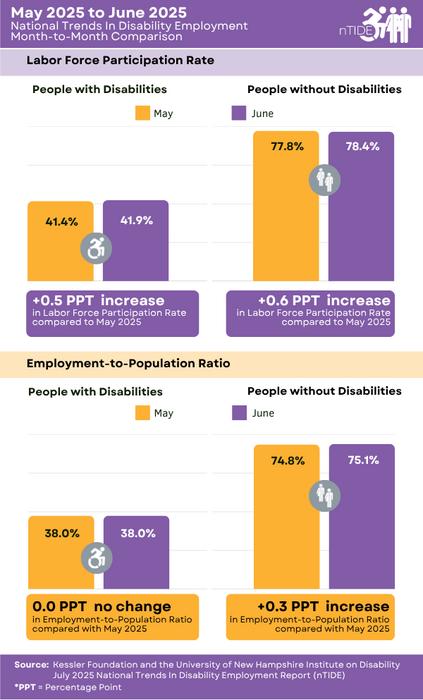East Hanover, NJ – July 3, 2025 – The National Trends in Disability Employment (nTIDE) report, jointly issued by the Kessler Foundation and the University of New Hampshire’s Institute on Disability, reveals a nuanced landscape of employment stability and evolving labor market engagement among people with disabilities in the United States. This latest data underscores the complex dynamics between employment rates and labor force participation during a period of economic uncertainty, offering critical insights into workforce inclusivity and policy development.
The month-to-month analysis comparing May and June 2025 highlights that the employment-to-population ratio—a core metric reflecting the proportion of individuals working relative to the total population—remained static at 38.0 percent for people with disabilities aged 16 to 64. Contrastingly, individuals without disabilities witnessed a modest increase, moving from 74.8 percent to 75.1 percent. This differential stability points to persistent challenges faced by disabled workers in gaining employment despite incremental economic shifts.
The labor force participation rate, which captures those employed or actively seeking employment, rose marginally among people with disabilities from 41.4 percent in May to 41.9 percent in June 2025, indicating a subtle increase in workforce engagement. Similarly, the non-disabled population saw a rise from 77.8 percent to 78.4 percent. This divergence between participation and employment rates among people with disabilities suggests that more individuals are entering or re-entering the labor market, though this has yet to translate into significant employment gains.
Experts interpret these patterns as symptomatic of broader economic and policy uncertainties. John O’Neill, PhD, director of the Center for Employment and Disability Research at Kessler Foundation, notes that employer hesitation to adjust hiring practices remains prevalent, largely awaiting clarity on federal budget allocations and their downstream impacts on state and local economies. This cautious stance is consistent with observed labor trends during periods of fiscal unpredictability.
Adding further context, Andrew Houtenville, PhD, professor of economics at the University of New Hampshire Institute on Disability, explains that employment rates rarely shift rapidly amid economic slowdowns due to employers’ reluctance to lose workers who are hard to replace. However, the uptick in labor force participation could signal that families and individuals with disabilities are increasingly compelled to seek work proactively as a hedge against economic volatility, even if job availability remains constrained.
A year-over-year comparison between June 2024 and June 2025 reflects a slight improvement in employment outcomes for people with disabilities, with the employment-to-population ratio rising from 37.6 to 38.0 percent. During the same period, the ratio remained stable at 75.1 percent for those without disabilities. Such incremental progress, while modest, may indicate a gradual shift in labor market inclusion.
Similarly, labor force participation for people with disabilities held steady at an increased rate of 41.9 percent in June 2025 compared to 41.4 percent a year earlier. For non-disabled individuals, participation rates remained constant at 78.4 percent, reinforcing the disparity in engagement trajectories between these groups.
The workforce composition in June 2025 included 6,654,000 workers with disabilities aged 16 to 64, representing 4.4 percent of the total U.S. workforce of 152,690,000. This figure provides an essential benchmark for assessing both representation and the potential untapped labor pool within this demographic segment.
The technical nuance embedded in nTIDE’s methodology is noteworthy. While grounded in U.S. Bureau of Labor Statistics (BLS) data, nTIDE refines its analyses by customizing population parameters to the working-age group of 16 to 64 years, enhancing specificity to the prime labor market cohort. Moreover, nTIDE integrates indicators such as the employment-to-population ratio and labor force participation rate to distinguish between actual employment levels and the extent of active job-seeking behavior in the disabled and non-disabled populations.
nTIDE’s ongoing monitoring and bi-monthly reporting offer a vital real-time perspective on how macroeconomic factors and policy shifts influence the labor market experiences of people with disabilities. These insights serve not only academic and policy-making audiences but also inform advocacy and employer engagement strategies aimed at improving employment outcomes.
Complementing the data reports, nTIDE conducts Lunch & Learn webinars to disseminate findings, foster dialogue, and field public queries about disability employment trends. The July 3, 2025 session features expert panelists including Josie Badger of the SPAN Parent Advocacy Network alongside researchers from Kessler Foundation and the University of New Hampshire, further emphasizing the commitment to knowledge exchange and community involvement.
The collaboration between Kessler Foundation and the University of New Hampshire Institute on Disability epitomizes the integration of rigorous research with practical advocacy. Kessler Foundation’s comprehensive focus on rehabilitation research transcends mere data analysis by developing and testing interventions that target improving quality of life and workforce participation for individuals facing neurological, developmental, and physical disabilities.
As economic conditions remain fluid, these findings invite a deeper exploration of structural barriers, employer incentives, and policy frameworks that influence hiring and retention of workers with disabilities. The steady employment rates combined with rising labor force participation highlight both persistent challenges and signs of resilience within this vital segment of the American workforce.
This expanded understanding permits stakeholders across government, private sector, and community organizations to tailor strategies that can better support employment inclusion, addressing not only statistical measures but also the nuanced lived experiences underlying workforce participation data for people with disabilities.
Subject of Research: Employment trends and labor market participation among people with disabilities compared to those without disabilities in the United States.
Article Title: National Trends in Disability Employment: Stability Amidst Shifting Labor Force Participation
News Publication Date: July 3, 2025
Web References:
- https://kesslerfoundation.org/
- http://www.researchondisability.org/
- http://www.bls.gov/news.release/empsit.nr0.htm
- http://www.ResearchonDisability.org/nTIDE
Image Credits: Kessler Foundation
Keywords: Economics, Economics research, Socioeconomics, Population studies




